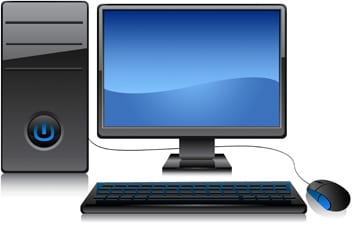
Computer-related Visual Stress
- Visual Stress Checklist
- Direct Visual Signs and Symptoms
- Indirect, Visually-Related Signs and Symptoms
- The Link Between Computers and Vision Problems
- How Can Behavioral Optometry Help?
Interpreting the glowing symbols on computer screens has created a new source of stress on our visual systems’ capabilities.
 More than half of all computer operators experience eyestrain, headaches, blurred vision, and other symptoms directly and indirectly related to increased sustained near point visual stress. Visual stress also may underlie complaints of general body fatigue, reduced efficiency at work and higher error rates as the day progresses.
More than half of all computer operators experience eyestrain, headaches, blurred vision, and other symptoms directly and indirectly related to increased sustained near point visual stress. Visual stress also may underlie complaints of general body fatigue, reduced efficiency at work and higher error rates as the day progresses.
Optometrists have found that most of these symptoms are alleviated through a combination of correcting workstation conditions, posture, stress-relieving lenses prescribed specifically for computer operation, and in some cases, through improving visual skills with vision therapy.
Today, the majority of people, including children, are computer users. If what has been learned about vision and computers is ignored, millions will discover that visual stress can generate serious, often permanent, vision and eye problems.
This pamphlet is a guide for making life with computers less stressful, more comfortable and more productive.
Humans have hunter-soldier eyes, essential to survival for spotting game or danger at a distance. But during the past half-century, nearly all our work and much of our recreation have shifted to seeing within arm’s length.
 The resulting near-point visual stress – despite 20/20 distance visual acuity – often produces both temporary and sometimes permanent adaptive changes, including nearsightedness, suppressed vision in one eye, poor eye teaming and reduced performance both at work and at play.
The resulting near-point visual stress – despite 20/20 distance visual acuity – often produces both temporary and sometimes permanent adaptive changes, including nearsightedness, suppressed vision in one eye, poor eye teaming and reduced performance both at work and at play.
Although computer manufacturers have vastly improved their products, some computer operators find their existing visual difficulties with near-point visual activities are complicated by sometimes blurred characters, an increase in the number and complexity of necessary eye movements and focusing shifts. Poor lighting conditions, glare, distracting reflections and flicker can also play a role in visual stress.
Changes in the way work is done will affect many first time computer users. Jobs which formerly allowed physical movement and opportunities to look away from near work now require extended, concentration on a computer screen image.
Many people who could handle the visual stress of intermittent near work simply cannot deal with prolonged near-point tasks.
Visual Stress Checklist
Computer-related visual stress may underlie many direct and indirect symptoms. Eyestrain is a common direct symptom, while the need for shifts in posture and muscular strain resulting from an ill-arranged workstation are among the indirect symptoms.
Direct Visual Signs and Symptoms
- Headache accompanying or following computer use
- Eyestrain
- Irritated eyes
- Blurred vision
- Slow refocusing when looking from copy or screen to distant objects
- Frequently losing place when moving eyes between copy and screen
- Difficulty seeing clearly at distance after prolonged computer use
- Occasional or frequent doubling of vision
- Changes in color perception
- Present lens prescription fails to relieve symptoms
Indirect, Visually-related Signs and Symptoms
- Neck or shoulder tension, pain
- Back pain
- Excessive physical fatigue when using computer
- Irritability increases when using computer
- Pain in arms, wrists or shoulders when working
- Increased nervousness
- Lowered visual efficiency and more frequent errors
The Link between Computers and Vision Problems
If you suffer from any combination of direct or indirect conditions, it is time to have a behavioral optometrist evaluate your visual skills and performance.
 The optometrist’s recommendation may be the key to making work less stressful, less painful, and more productive. And, you may avoid the onset of more permanent visual and eye conditions now observed by optometrists among their computer-using patients.
The optometrist’s recommendation may be the key to making work less stressful, less painful, and more productive. And, you may avoid the onset of more permanent visual and eye conditions now observed by optometrists among their computer-using patients.
Characters on older computer screens are sometimes fuzzy-edged and are constantly decaying and being regenerated. Add to that scrolling, flicker, screen edge distortions, improper contrast and other disturbing workstation conditions and visual problems may develop.
Symptoms and discomfort are the warning signs that something must be done to reduce the possibility of serious, permanent vision or eye problems that can alter and diminish the quality of life.
How Can Behavioral Optometry Help?
Behavioral optometrists have found that the visual care needs of computer operators differ from those who work with paper and must include detailed analysis or work situations as well as more extensive, specialized visual testing.
For many people, visual stress can be virtually eliminated through stress-relieving lenses specially prescribed and meant only for computer operation. These become “tools for that job” not signs of a defect.
Eye teaming and scanning problems may require vision therapy to develop the ability to efficiently track and move both eyes together.
Behavioral optometry is an umbrella term which also includes developmental and functional optometric practices. Not all optometrists practice behavioral optometry. To find one who does, contact the Optometric Extension Program Foundation, (949)250-8070, cep@oep.org, www.oepf.org, or make sure you receive a “Yes” answer to each of the following questions.
- Do you provide a full series of near-point vision tests?
- Do you provide work- or school-related visual perception tests?
- Do you provide full vision care including vision therapy in your office, or will you refer me to a colleague, if needed?
- Will you see me again during the year, and periodically, to determine my progress?
